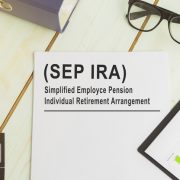What are the Contribution Limits in a Self-Directed SEP IRA?
A Self-Directed SEP IRA, or a simplified employee pension IRA, is one of the best ways for self-employed people to begin using the retirement tax advantages they have available to them. In a SEP IRA, an investor can make substantial pre-tax contributions to their retirement account, wherein the money grows tax-free until the investor hits retirement age. At that point, the investor can then take money out through distributions and pay the taxes on the money.
The question for many, however, is how much you can contribute. And there’s not a straightforward answer. If you visit the IRS website, for example, you’ll find out that your contributions cannot exceed the lesser of two options:
- 25% of the employee’s compensation, or
- $58,000 for 2021
For many people, this can be confusing. Why isn’t there one set limit? And understanding this will help you understand why the Self-Directed SEP IRA is such a unique plan.
Understanding the SEP IRA
With a SEP IRA, only the employer contributes. This includes you, if you’re self-employed. This should help put things in perspective, because it means that if you’re both the self-employed and the only employee of your business, then 25% of your employee’s compensation can potentially be your compensation. (Make sure that you consult with a tax professional for any advice on how much you can contribute to your particular situation.) One key area to understand with SEP IRAs is that there are no universal answers here. One person’s contribution limit might not be the same as another’s.
Some people think that the “25%” rule means that they can contribute about as much as they want, provided that their compensation is high enough. But this isn’t exactly true. Because you must select the lesser of the two options, there is always going to be an upper limit to how much you can contribute to a SEP-IRA.
But let’s put that in context. With other Self-Directed IRAs, such as a Roth IRA, your contributions are going to be static and far more limited than they are with the SEP. In other words, the SEP can give you a lot more retirement investing flexibility. In fact, many people add a SEP IRA to their portfolio when they begin self-employment because it is such an important way to build a retirement nest egg for themselves. But since self-directing means you’re in charge, you have to remember that ultimately, it will be up to you to make the decisions.
Why Choose a Self-Directed SEP IRA?
We can’t tell you which account may be appropriate for your situation. That will be up to you and a qualified financial professional. However, we can tell you the specifics of the SEP IRA that are appealing to self-employed individuals. Perhaps highest on that list is the high contribution limit. Yes, it’s true that the contribution limits aren’t the same for everyone. But when you consider the potential contribution limits, you’ll likely find that if you have the appropriate qualifications, you can put aside a substantial amount of money every year when you use a Self-Directed SEP IRA.
We can also tell you that self-directing means you can access a wider range of retirement assets than many people are used to. That includes real estate, precious metals, tax liens, private companies, and more. Interested in learning more about Self-Directed IRAs? Contact American IRA, LLC at 866-7500-IRA (472) for a free consultation. Download our free guides or visit us online at www.AmericanIRA.com.








